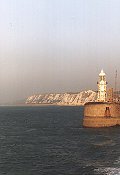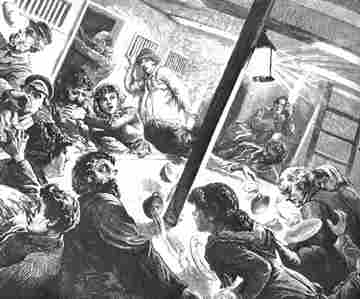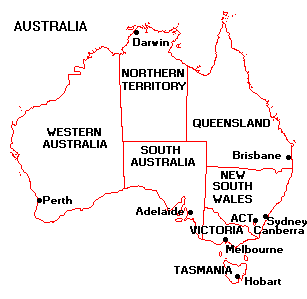A TYPICAL JOURNEY
(using Cornwall's Great Migration c.1848 which coincided with the decline in copper mining, as our example) |
|
They went to the Emigration agents and applied for assisted passage. John Oatey understood he had to be healthy, sober, industrious and in the habit of working for wages. His application form required his own signature plus four others - two from 'respectable householders, one from a physician or surgeon confirming the good health of John and his family, and one from a clergyman confirming their good moral character. The Emigration Commissioners approved John Oatey's application (probably taking into account that he was young, strong and a stone mason) and he received an approval circular. Not long after that they received their embarkation orders. John and his family, together with Jeremiah and Phillipa Oatey (John's relatives) would have made their way from their home at 'Highlanes' in Hayle, to Plymouth, a journey of about 80 miles (130km), via Cambourne, Redruth, Truro, St Austell and Liskeard. Together with other passengers also waiting to board the WILLIAM MONEY bound for South Australia, they stayed in the Embarkation Depot. Each dormitory housed some 60 -70 people. These were not the most comfortable in the world, but as it was only for two nights they put up with the cold stark accommodation. They were told their quarters on board the "William Money" would be just as cramped. In the meantime their ship left London, loaded with a variety of goods needed in the colony, arriving in Plymouth "before noon on September 14, 1814". The WILLIAM MONEY was built in 1820 in Calcutta for Green and Co. of Bristol, measured 142ft long, by 36ft wide and 26.6ft in height, and nearly re-built in 1829. It had only just come out of drydock having just been 'newly coppered'. The Ship's Charter specified that there had to be a certain amount of deck space for each passenger and proper bed places with curtains, seats, desks, tables, and a school. The ship's surgeon Mr Kemball was provided with his own cabin and permitted to dine at the Captain's table. There were separate hospitals for males and females, water closets, an oven for making bread and a large bathing tub and clothes lines were also provided for the passengers. During the next four days 372 emigrants were checked by the government inspectors, and then given permission to go on board. John and Susan found they were accommodated below decks, in the centre of the area known as 'steerage'. They discovered that many of their fellow passengers were also from Cornwall, and some came from Ireland and Scotland. Almost all these passengers were 'assisted migrants' (passage paid by the South Australian Governments). We understand that some of those on board were required to pay their own passage, having been declared ineligible for 'free passage'. They wanted to sail on the WILLIAM MONEY as they were relatives of the emigrants. They were: Rebecca Stevens(44), Loveday Williams (51), Robt. Sergeant (21), Eliza Burgh (40), Johanna William (17), Elizabeth Nankervis (57), Wm Wade (48), William Rayner (54), Jane Hooper (60) and Phillippa Varco (60) and James Wright. To view this document CLICK HERE On Tuesday September 19th, 1848, the 'William Money' was taken about two miles outside the Plymouth harbour by a towing-tug and when the connecting lines were dropped the tug moved away. The ship's three masts gleamed in the sunshine, making a spectacular sight as they left Plymouth at 5pm bound for South Australia. The run down the English Channel began with a fair wind, but after the first day it freshened to a stiff breeze and the ship began to roll and pitch in a manner that the passengers found alarming. Amongst the single men the first few hour of sailing had been spent in high spirits with much jocularity, but as the day ended everybody became more subdued, and although few would admit it, most of them were struggling with the first signs of seasickness. It took several days of fine weather to restore most of the passengers to good spirits and normal eating habits. 66 married males and 64 married females, 49 single males and 51 single females. Children under the age of 14 included 64 males and 57 females, Infants 11 male and 10 females. Births on board - 2 male, 4 female. Deaths on board - adults: 1 male, 2 females. Children: 3 male, 6 female. So many of our ancestors travelled the same road on their journey to Australia.  CLICK the Spinning Globe To see the original maritime route from Britain to Australia, and the changed route which virtually halved the passage time c.1800-1900 |
Click here to see PASSENGERS LISTS from 1836 to the 1860s The white cliffs of Dover  Our families felt the same anguish as so many others who left familiar shores and they felt the same homesickness when they thought of their families "back home". The average length of the voyage to Australia 'under canvas' from 1840 to 1860 was one hundred and eleven days while the shortest voyage on record was eighty three days.  They discovered they all felt the same discomforts on board ship as it journeyed right across the world to their new homes.  Eventually they settled down and began new lives in this new country of theirs AUSTRALIA. |
3 ounces of preserved soup and one egg every alternate day Voluntary Constables were selected from amongst the married men to receive and carry the provisions to and from the galley for the chefs to prepare the food. To read the CHARTER (the agreement between the shipping company and the captain) for the 1848-49 voyage of the 'WILLIAM MONEY' CLICK HERE The South Australian 'REGISTER' newspaper reported on January 8,1849 that the numerous arrivals of able-bodied mechanics and Labourers by the 'WILLIAM MONEY' and the 'RAJAH' have caused very little apprehension to their brethren who had preceded them, such is the abundance of employment in almost every branch of active industry. What is most regretted is the want of immediate accommodation for the newly arrived. Those that have a little money, in most cases, find it difficult to procure accommodation at the inns, and those who are 'without funds' are often obliged to retrace their weary steps back to the Port for the sake of a night's lodging on the ship. Note: the Ship's charter provided for this possibility: The berths of the passengers shall not be removed or disturbed until the expiration of the fourteen days allowed for disembarkation, unless the passengers shall have previously finally quitted the ship. |
have the good fortune to locate a diary of the actual voyage. JAMES MENZIES wrote a diary of his voyage on board the 'WILLIAM MONEY' (Passenger List) which left Plymouth on September 19, 1848 bound for South Australia, arriving on January 3rd, 1849. To read this Diary CLICK HERE Letitia Jenkinson left Fenagh, County Carlow, Ireland and travelled to Australia on board the 'OCEAN CHIEF' (Passenger List) which arrived in Melbourne in 1856. Sir Charles Gavin Duffy travelled on board the same ship and described the voyage in his journal. To read this journal CLICK HERE |

Any and all copyrighted graphics are acknowledged as of their respective owners.